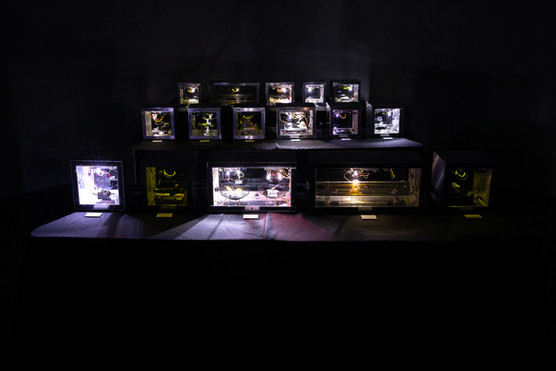www.simonwhetham.co.uk
'Made to Malfunction' installation of repurposed devices from discarded technology
News
"Made to Malfunction" was selected to be shown during Electric Spring Festival at University of Huddersfield, UK in February 2020.
In September 2019 it was also hosted as part of In Vitrø sound art exhibition, organised by LOXOSconcept for Matera Euro Capital of Culture 2019, Italy.
Project background
Simon Whetham was selected to participate in the Creators in Lab residency programme at ACC in Gwangju, South Korea from September until December 2018. During the project development he learned how to combine his interest in using discarded technology and unpredictable results with Arduino programming to make a collection of objects that emit sound from salvaged devices at random intervals.
"Made to Malfunction" was exhibited as part of the ACC Showcase at the Asia Culture Center in Gwangju, South Korea from 14-23 December 2018, and subsequently at Openarts Space MERGE, Busan, South Korea from 12-21 February 2019.
Below is video documentation of the work, as the audience saw it in the space, plus photographs below this that show how the sound making boxes were exhibited.
Please click HERE to view the individual boxes and see more details about them and HERE to view the project development.
"Made to Malfunction" an explanation by Simon Whetham
Maybe it's not common knowledge but for some time the idea of 'planned obsolescence' has been adopted by manufacturers of almost everything we use in our daily lives, especially with newer technology. The idea is that a product is designed to have a certain lifespan, after which it will almost certainly fail and need replacing. Manufacturers are not going to supply us with objects and devices that last forever - this is not a good business plan!
And especially in more 'developed' countries, replacement is often more convenient and cheaper than repair.
In my work I mostly use found objects and discarded technology because, apart from being an inexpensive way of sourcing materials to work with, I also enjoy the process of finding a new use for something that possibly does not now do what it was designed to.
In the past I have used field recordings to trigger motors in a more random way than simply sending an electrical signal, but I wanted to find a method of doing this using technology such as Arduino. Having bought an electronic kit of a random movement toy, I knew it was possible, and in this project (thanks to some basic Arduino programming lessons from Hankil) I have been learning how do actually programme motors to move in unpredictable ways.
A new discovery for me was the stepper motor, which you find in printers and scanners as they can be programmed to stop movement in precise positions. They can also be programmed to move in both directions very quickly.
The second video clip above shows a stepper motor in action.
One final point I want to mention is, in seeing and hearing many kinetic artworks and sound artworks that use motors in some way, the sound of the motor seems to have been overlooked and, for me, can be a distraction in some pieces. My work will accentuate the sound as much as possible. I feel to hear the motor changing speed and direction is integral to my concept.
From technology that was abandoned because it ceased to function well, I will make sounding objects that one the face of it also don't work, but the motor only moving at odd times and the sound of the movement is intentional - exaggerated even!
Many thanks to artists Hankil Ryu and Martin Miller, and fellow participants Sergio Bromberg and Earl Park for support and assistance.
















